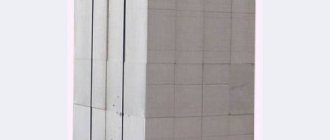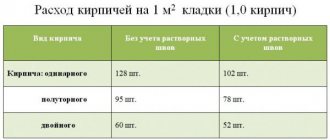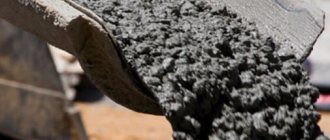Types of bricks
To calculate, you need to know what type of brick will be used:
- single has standard dimensions of 25x12x6.5 cm. Very often used, well suited for alternating longitudinal and transverse rows and any types of masonry;
- one-and-a-half differs from the previous one in height (88 mm);
- double , whose height is increased to 138 mm, is used for short construction times.
You need to know the dimensions to determine how many bricks are in 1m3 of masonry. To determine the quantity, the width of the wall is important . The laying is done in half or a whole brick. When making calculations, the width of the laying joints, which are also included in the volume, is taken into account.
Return to content
Number of bricks
To calculate the required value, you must determine what number will be obtained:
- with seams, the amount of material needed for masonry is calculated;
- without seams it is calculated how many bricks need to be bought.
Manufacturers form cubes of brick on a pallet. Using known dimensions, you can easily determine how many different types of brick are used per 1m3 of masonry:
| Product type | No seams | With seams |
| Single | 512 pcs. | 394 pcs. |
| One and a half | 378 pcs. | 302 pcs. |
| Double | 242 pcs. | 200 pcs. |
Knowing the amount of brick in 1 m3 allows you to avoid surpluses after construction . It also makes it possible not to interrupt work due to a lack of materials. You may need to do the calculation yourself, so you need to familiarize yourself with the algorithm.
Return to content
Excluding seam
The number of bricks is calculated according to a single principle , regardless of the size of the products. Calculate using the example of a single product (25x12x6.5cm). First, we determine the volume of one brick (multiply the width with the height and length). The resulting value is 1950 cm3 (1m3 = 1 million cm3). The number of bricks is determined: 1 million cm3 / 1950 = 512.82 pieces.
Return to content
With seam
The thickness of the seam affects how many bricks are in 1m3 of masonry. For example, this value is somewhere around 1.5 cm (this figure is usually used). This number is added to the brick size . For a single product it turns out:
- length – 25 cm + 1.5 cm = 26.5 cm;
- height – 6.5 cm + 1.5 cm = 8 cm.
The thickness of the seam is not added to the width . The resulting volume is: 26.5 x 8 x 12 = 2544 cm3, 1 million cm3 / 2544 = 393 pcs. Similarly, you can determine the values for thickened, double bricks.
Calculations are given for bricks produced in accordance with GOST . The table shows how many bricks are in a cube for a material made according to standards. Using this principle, the number of products with other sizes is calculated:
- First the dimensions are measured ;
- the volume of the brick is determined (the length is multiplied with the height and width);
- if the calculation is carried out without a seam, then divide 1m3 by the obtained value;
- the required quantity is obtained ;
- when a seam is taken into account, its thickness is added to the length and height ;
- using these values the volume is calculated .
Return to content
How many bricks are there in a cube without seams?
In such calculations, an important role is played by which type of brick will be used. After all, each species has its own size. Its volume and, as a result, the quantity in one cube depends on this. The dimensions of the stone are calculated by multiplying the length with the height and width. It turns out that the calculation of bricks in 1 m 3 is based on the dimensional values of the material.
Typically, brick blocks are produced according to the sizes established by GOST.
Brick dimensional parameters:
- Single: 0.12 m wide, 0.065 m high, 0.25 m long.
- One-and-a-half: (thickened) 0.12 m wide, 0.088 m high, 0.25 m long.
- Double: 0.12 m wide, 0.138 m high, 0.25 m long.
When obtaining the volume, for example, of a thickened (one and a half) brick, we multiply 0.12 m * 0.088 m * 0.25 m and get 0.00264 m 3.
Then, to determine the amount of stone per cubic meter, we divide 1 m 3 by the result obtained: 1/0.00264 = 378.78 and we get 379 pieces.
Carrying out the same steps for the other two types of bricks, we get the volume and quantity:
- single 0.12 m*0.065 m*0.25 m = 0.00195 m 3 and 513 units,
- one and a half 0.12 m * 0.088 m * 0.25 m = 0.00264 m 3 and 379 units,
- double 0.12 m*0.138 m*0.25 m = 0.00414 m 3 and 242 units.
Note. One cubic meter is divided by the volume of the stone, also in cubic meters.
Square meter of masonry
When raising walls, red brick calculations are made in squares . Its quantity depends on the size, laying method, and thickness of the seam.
It must be taken into account that during the work part of the brick will be accidentally damaged. Therefore, the value obtained from preliminary calculations should be increased by 5% of this number . If you plan to lay arches, figured window openings, etc., then 14-15% more bricks will be needed.
How many bricks per square meter depends on their type and thickness of the masonry . The number of single products per 1 m2 for half-brick masonry is determined as follows. It is necessary to determine the area using known dimensions: 25 x 6.5 cm = 162.5 cm2. There are 10,000 cm2 in 1 m2, so it is calculated: 10,000 / 162.5 cm2 = 61.5 pieces. The number of products per 1 m2 is determined in a similar way when masonry of a different thickness is performed.
The amount of one-and-a-half bricks for masonry of half a brick is calculated according to the dimensions: 25 x 8.8 cm = 220 cm2. Next, the number is determined: 10000 / 220 cm2 = 45.45 pieces. The number of products for masonry of a different thickness is also calculated. Using the known dimensions of a double brick, the required values are obtained in the same way.
The principle of determining the number of bricks is also suitable for products with non-standard sizes . First, the area of the sidewall is calculated, 1 m2 is divided by the resulting value. This is how the number of products in 1m2 of masonry is calculated. When it is necessary to take into account the width of the seam, 1.5 cm is added to the dimensions of the brick and calculated according to the above diagram.
Table of brick consumption per 1m2
| Wall thickness | Product type | No seams | With seams |
| single | 61 pcs. | 51 pcs. | |
| 12 cm (0.5) | one and a half | 45 pcs. | 39 pcs. |
| double | 30 pcs. | 26 pcs. | |
| single | 128 pcs. | 102 pcs. | |
| 25 cm (1) | one and a half | 95 pcs. | 78 pcs. |
| double | 60 pcs. | 52 pcs. | |
| single | 189 pcs. | 153 pcs. | |
| 38 cm (1.5) | one and a half | 140 pcs. | 117 pcs. |
| double | 90 pcs. | 78 pcs. | |
| single | 256 pcs. | 204 pcs. | |
| 51 cm (2) | one and a half | 190 pcs. | 156 pcs. |
| double | 120 pcs. | 104 pcs. | |
| single | 317 pcs. | 255 pcs. | |
| 64 cm (2.5) | one and a half | 235 pcs. | 195 pcs. |
| double | 150 pcs. | 130 pcs. |
If the quantity of different bricks for masonry of a specific thickness is known, then it is easy to determine the required volume of material and calculate the cost of the planned work. When the exact number of bricks in 1m3 is known, then no extra money will be spent .
Return to content
Number of bricks in a pallet
When purchasing material in large quantities, for large-scale construction work (masonry, cladding, etc.), a whole batch of bricks is purchased. To do this, you need to know how many units of goods fit in a pallet. It’s quite easy to count a few bricks, but what if there are tens of thousands of bricks? To facilitate loading/unloading, bricks are placed on pallets .
Industry today produces about 15 types of these products. Products differ from each other not only in characteristics, but also in dimensions . Therefore, different numbers of bricks fit on pallets. If the exact number of products is known, then you can preliminarily determine how much the car will carry per trip.
You can check the weight of the product upon purchase; it must be indicated in the certificate. When you rent a hired vehicle, you will have to pay for each trip. Without information about how many bricks are in a cube, it is impossible to minimize costs.
Brick is a fairly expensive building material. It is used in a very specific way. It is not purchased with a reserve; there is no point in spending funds on surplus. A certain amount of brick is placed on a standard pallet:
- basement – 480;
- dihedral - 375 (220x90x 65 mm);
- single-sided - 307 (its length is 250 mm);
- smooth – 275 (250x120x65 mm).
There are many products on the market that are produced not by large companies, but by small enterprises. They do not all comply with manufacturing technologies and GOST size requirements . You can also come across dishonesty of sellers who expect that rarely will anyone recalculate the number of bricks. According to GOST, 2 standard sizes of pallets are used, and which one the seller uses is still unknown.
always better to count the purchased goods . It is quite easy to determine how much sand-lime brick is placed on a pallet. It is necessary to determine:
- number of products in a row;
- number of rows on each side;
- multiply the resulting numbers ;
- the number of products has been counted.
Data on the number of single products in different sources differ slightly. This can be considered an argument for recalculating the purchased goods.
It is recommended to purchase bricks in slightly excess of the required quantity (by about 5%) . Because products may be rejected after delivery and unloading at the construction site. There may be manufacturing defects that prevent the use of this brick.
Sometimes it is advisable to calculate the volume of production. When the exact dimensions of solid bricks are known, the volume of the purchased batch is accurately determined.
The dimensions of the products located on the pallet are measured and multiplied. the batch size is obtained .
How many bricks are in one cube - How many bricks are in 1 cube | Useful tips
Correct calculation of the required volume of bricks when building a house or other objects allows you to accurately determine the amount of mortar for laying them. In addition, do not forget about the correct choice of vehicle for delivering this building material. With a known number of units and a correctly determined volume, it is possible to accurately determine and order a truck with the required load capacity.
In practice, bricks are divided into three most common types, the sizes of which differ:
- single;
- one and a half or thickened;
- double.
Of the listed types, the most popular and popular among builders are single blocks. In the construction of medium-sized buildings, one-and-a-half silicate bricks are also often used. The double type serves as the main building material for laying partitions, interior walls, etc.
Since the mentioned types have different sizes, as well as their individual volume, their quantity in 1 cubic meter. m will be different.
In order to determine how many bricks are in 1 cube, you first need to know the dimensions of the type used. A standard single block with dimensions of 250 mm x 120 mm x 65 mm has a volume of 1950 cubic meters. cm. The dimensions of the one-and-a-half brick are 250 mm x 120 mm x 88 mm, and its volume is 2640 cubic meters. cm. A double brick with dimensions of 250 mm x 120 mm x 138 mm has a volume of 4140 cubic meters. cm. When calculating the number of blocks at the masonry stage, it is necessary to take into account the expected thickness of the mortar joints. This indicator is not used for simply counting the number of pieces in one cubic meter.
The formula for calculating how many bricks are in 1 cubic meter looks approximately as follows:
Length * Width * Height = Volume of one brick.
Then, knowing the volume of one unit of the type of brick used, you should calculate the total number of blocks per 1 cubic meter. m:
1 cu. m / volume of one brick = total number of blocks
The table below contains data regarding the number of bricks in 1 cubic meter. m depending on their size:
| Brick type | Length | Width | Height | Volume of 1 block | Number of bricks in 1 cubic. m |
| Single | 250 mm | 120 mm | 65 mm | 1950 cc cm | 513 pieces |
| One and a half | 250 mm | 120 mm | 88 mm | 2640 cc cm | 379 pieces |
| Double | 250 mm | 120 mm | 138 mm | 4140 cc cm | 242 pieces |
Incorrect calculation of the required number of bricks may affect the overall estimate of construction work, since if the quantity is insufficient, additional costs will be required for the delivery of the missing batch. When it comes to calculating the material for decorative finishing with colored bricks, there may be a risk of purchasing goods from different production batches, the color saturation of which may differ.
An expert in the countryside real estate market, Villa66 offers land plots in Yekaterinburg and the region at competitive prices.
villa66.ru
How many bricks are in a cube - table for calculating bricks in 1 m³
Planning is the most important at each stage of construction. This is what influences the demand for information about how many bricks are in a cube. After all, knowing the answer to this question, you can not only calculate the required amount of materials, but also the full cost of erecting walls in the room.
How to find out how many bricks are in a cube?
First of all, it is important to understand what dimensions the building material has. So, single ceramic brick is the most common. It is used mainly to build foundations, walls, both for the interior and exterior of outbuildings, etc.
In accordance with the established GOST number 8394-73, the dimensions of the working brick are clearly established. Its length is 25 cm, height 6.5 cm, and width 12 cm. At the same time, such parameters of one unit of material allow you to lay brick in any way, be it lengthwise or crosswise. To speed up the building construction process, you can use one and a half brick sizes, the dimensions of which are 250 * 120 * 138, mm. The double brick also has considerable dimensions - 250 * 120 * 138 mm. But this type of brick has a fairly low level of strength and is not recommended for use for the construction of foundations or lower parts of buildings.
How many bricks are in a cube - excluding seams. Calculation
To understand the volume of 1 brick block, the length is multiplied by the width, and if you use an ordinary brick, then:
0.25 * 0.12 * 0.065 = 0.00195 cubic meters
Next, 1 cubic meter is divided by the resulting number. As a result we get:
Source: https://sargorstroy.ru/raznoe-2/skolko-shtuk-kirpicha-v-odnom-kube-skolko-v-1-kube-kirpichej-poleznye-sovety.html











